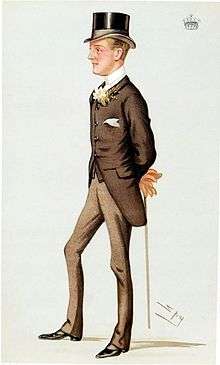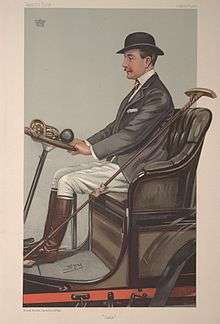Charles Chetwynd-Talbot, 20th Earl of Shrewsbury

Caricature of Talbot, aged 19, by
Leslie Ward in Vanity Fair, July 1880
.jpeg)

Major Charles Henry John Chetwynd-Talbot, 20th Earl of Shrewsbury, 20th Earl of Waterford, 5th Earl Talbot KCVO (13 November 1860 – 7 May 1921), styled Viscount Ingestre from 1868 to 1877, was a British peer.
Family background
Talbot, who was born at Eaton Place, Belgravia, London,[1] was the only son and heir of Charles Chetwynd-Talbot, 19th Earl of Shrewsbury and 4th Earl of Talbot. His grandfather, Henry Chetwynd-Talbot, 18th Earl of Shrewsbury, had inherited the earldoms from a very distant cousin, and had to prove his claim to the premier earldoms of Britain and Ireland on the Roll in the House of Lords, by demonstrating his descent from the 2nd Earl of Shrewsbury and Waterford. Talbot was the brother of Gertrude who married the 13th Earl of Pembroke, and, a notable hostess, Theresa who married the 6th Marquess of Londonderry.
Inheritance
Talbot's very rich father died when Talbot was a schoolboy of 16.[2] All his father's real and personal estate was left to Talbot's mother.[3] She lived until 1912 when he was aged 51.
Education and marriage
Talbot was educated at Eton College[1] and inherited his titles when only sixteen years of age. Aged nineteen he eloped with an older married woman, Ellen née Palmer-Morewood, wife of commoner, Alfred Edward Miller Mundy of Shipley Hall whom she had married in 1873. Ellen was a granddaughter of the 7th Baron Byron (a cousin of the poet Lord Byron, the 6th Baron), and already had a daughter. Talbot's heir, Lord Ingestre, was born less than three months after the marriage of his parents. Ingestre died in the lifetime of his parents, but had several children including the father of the current Earl, 21st Earl of Shrewsbury and Waterford.
Public offices and honours
In right of his peerage Talbot became Hereditary Lord High Steward of Ireland, in which capacity he took part in the coronations of Kings Edward VII and George V, and accompanied the former on his state visit to Dublin in July 1903. He was made KCVO in 1907.[1] He also became High Steward of the Borough of Stafford in 1892.[1]
Equestrian interests
He started his own polo club in 1893.[4] In 1895, he founded the Staffordshire Polo Club at his house, Ingestre Hall.[4] Players included Charles Stanhope, 8th Earl of Harrington, Algernon Burnaby, Captain Daily Fergusson, Captain the Hon. Robert Greville, Gerald Hardy, Albert Jones, Captain "Wendy" Jones, Edward and George Miller, Norman Nickalls, Bertram Portal, Captain Gordon Renton, Jasper Selwyn and John Reid Walker.[4]
Greyhound coach

A devotee of coach driving for several seasons he ran the daily Greyhound (i.e. fast) coach service the 20 miles from fashionable Buxton Spa to his house, Alton Towers, now the site of a theme park.[5]
Investing in personal transportation
Hansom cabs de luxe

For many years he was in business as a hansom cab owner, his vehicles marked "S.T" (for Shrewsbury and Talbot) and the horses "being of the best possible quality",[1] and he was the first owner to have cabs that were fitted with noiseless tyres operating in London and Paris.[5]
 Then aged only 23 he began in Westminster, London in the summer of 1884 with 35 Forder Royal Hansom cabs made by Forder of Wolverhampton, who held royal warrants for their carriages and made luxury hansoms for private use. Talbot's were built to Forder's special patented design and they were of Forder's special lightweight construction. Each was fitted with rubber tyres[note 1] for passenger comfort which also had a side effect of lengthening the carriage's life. All his horses were hog-maned[note 2] and on the side of each cab was a coronet and the initials S and T at either side of it. The telephone was laid on to the stables so a cab might be called at a moment's notice.[6] |
To begin with drivers paid £1 a day for the use of the horse and cab keeping the remainder of their takings. In slack periods the drivers would strike asking Talbot for a price reduction. In the summer of 1888 he floated a public listed company, The Shrewsbury and Talbot Cab and Noiseless Tyre Company Limited, to buy two businesses. 1. the business of cab proprietor and job master worked by the Earl himself and 2. the business of The Noiseless Tyre Company Limited, manufacturers of steel and rubber tyres in Manchester and London.[7]
In the Spring of 1891 following almost annual strikes by his cab drivers Talbot put his company's 300 horses up for sale, under police protection, in the company's Battersea premises. At that time they operated from a number of yards in different parts of London. The press reported the terms offered to drivers in detail then the prices of the horses and advised that every animal put up for sale had been sold.[8] Strong competition from other rubber tyred cabs seems to have become a serious problem. The business was restarted in October 1891 with cabmen friendly to the company.[9]
Motoring
In November 1900 Talbot formed another public listed company, Shrewsbury S T and Challiner Tyre Company Limited, to manufacture and deal in cabs, carriages, motor cars, cycles, vehicles, tyres, tubes, wire, India rubber and gutta percha goods etc.[10] In December 1903 he was described in a court action brought by Dunlop over the importation of Michelin tyres as "proprietor of the business known as Maison Talbot in London's Long Acre managed by Mr Weigel."[11][note 3]
In March 1901 the earl formed British Automobile Commercial Syndicate Limited "with objects sufficiently indicated by the title". The shareholders were not people of note but provided addresses in the then almost semi-rural Ladbroke Grove, Notting Hill, Shepherds Bush areas and Hatton Gardens EC. One of the shareholders was a Mr R Weigel of 25 Maxilla Gardens North Kensington, the first chairman was - The Earl of Shrewsbury and Talbot.[12] The other first directors were M. Chabert, president of the Société Commerciale d'Automobiles, Paris and Mr D M Weigel, managing director. The new premises (formerly occupied by carriage builders) at 97-98 Long Acre (adjoining 1 Endell Street) covered "four large floors".[13] Twelve months later the Earl was made chairman of Messrs J Rothschild and Son Limited incorporated to carry on the business of making motor car bodies by expanding the London activities of the well known French businesses of Clément-Rothschild and Messrs J Rothschild and Son. The second floor of the same building was to be Maison Talbot suppliers of Talbot tyres (as fitted by the Hon C S Rolls), the third floor to be automobile clothing.[14] In March 1909 the earl made a formal announcement that he would close the business which could be seen to be competing with his Talbot agents.[15]
In 1909 he floated Homoil Trust Limited leading a board of the late engineer-in-chief of the Navy, another colliery owner and a well-known consulting engineer. The company was formed to purchase and develop various patents for the production of a cheaper home-produced and more efficient substitute for petrol made from coal-tar.[16] It was voluntarily wound-up at the end of 1910.[17]
Talbot motorcars
.jpg)
He founded Clément-Talbot Limited in 1903. He built for it the United Kingdom's first purpose-built automotive-manufacturing plant in London's North Kensington with his own personal crest set high above the entrance to the administration building. He involved Adolphe Clément-Bayard as his "engineer" and began by importing his popular French Clément-Bayard cars into Britain.
At Brooklands in November 1912 Lord Shrewsbury's Talbot car of only 25.6 horsepower rating driven by Percy Lambert attained a speed of 113.28 miles per hour and broke many other class records. The only faster car on the Brooklands track was a Mercedes-Benz of 84.8 horsepower rating.[18]
Military service
The Earl served entirely on home service in Britain during World War I. He was Major in the Army Remount Service of the Army Service Corps from 1914 to 1915,[1] and temporary Major with the Royal Welsh Fusiliers 1916 to 1917.[19] In January 1915 his only son, Viscount Ingestre, a reservist in the Royal Horse Guards at Regent's Park Barracks, died in London of influenza followed by pneumonia.[20][21]
Later life
The Earl died in May 1921, aged sixty, and was buried at the parish church of Ingestre.[1]
Notes
- ↑ An invention patented in 1883 allowed the manufacture of rubber tyred wheels at about one-tenth of the previous cost. The Shrewsbury And Talbot S. T. Cab Company (Limited) v. Sterckx. The TimesThursday, Dec 19, 1895; pg. 3; Issue 34764.
- ↑ The mane is cut very short and stands erect
- ↑ "Daniel M Weigel, managing director of the British Automobile Commercial Syndicate Limited. Started motoring in 1893 and has been a prominent figure in the business side of the industry ever since. In 1900 in conjunction with the Earl of Shrewsbury and Talbot he formed the British Automobile Commercial Syndicate Limited. Introduced the first "Clément-Talbot" car into England in 1901. In 1902 formed the firm of J Rothschild et fils Limited opening a London branch of that famous firm of Parisian motor-carriage builders. Is now connected with the firms of J Rothschild et fils Limited and the Maison Talbot, of the latter of which he is the managing director. Club A.C.G.B.&I." The Motoring Annual and Motorist's Year Book, 1904
References
- 1 2 3 4 5 6 7 The Complete Peerage, Volume XII. St Catherine's Press. 1953. pp. 729–730.
- ↑ Death Of Lord Shrewsbury. The Times, Saturday, May 12, 1877; pg. 12; Issue 28940
- ↑ WILLS AND BEQUESTS.-The will (dated August. The Times, Friday, Jul 06, 1877; pg. 12; Issue 28987
- 1 2 3 Horace A. Laffaye, Polo in Britain: A History, Jefferson, North Carolina: McFarland & Company, 2012, p. 29
- 1 2 Who Was Who, 1916–1928. A & C Black. 1947. p. 958.
- ↑ The Earl of Shrewsbury and Talbot, The Derby Mercury, Derby, Wednesday, June 11, 1884; Issue 8839
- ↑ Money-Market and City Intelligence. The Times, Thursday, Jun 07, 1888; pg. 12; Issue 32406
- ↑ Sale of the S T horses, The Standard,Friday, April 10, 1891; pg. 3; Issue 20829.
- ↑ The Recent Cab Strike. The Standard, Tuesday, October 06, 1891; pg. 3; Issue 20982
- ↑ New Company. Manchester Courier and Lancashire General Advertiser, Monday, November 05, 1900; pg. 3; Issue 13726.
- ↑ Motor Car Tyre Trade. The Nottingham Evening Post, Wednesday, December 09, 1903; pg. 6; Issue 7888.
- ↑ The Motor-Car Journal, Saturday March 9 1901
- ↑ The Motor-Car Journal, Saturday March 30 1901
- ↑ The Motor-Car Journal, Saturday February 22 1902
- ↑ The Motor-Car Journal, Saturday March 13 1909
- ↑ Homoil Trust, Limited. The Times, Tuesday, Jun 22, 1909; pg. 15; Issue 38992
- ↑ Law Notices, Nov. 22. The Times, Tuesday, Nov 22, 1910; pg. 3; Issue 39436
- ↑ 113 Miles an Hour. The Nottingham Evening Post, Monday, November 18, 1912; pg. 3; Issue 10668.
- ↑ Kelly's Handbook to the Titled, Landed and Official Classes, 1920. Kelly's. p. 1466.
- ↑ News in Brief. The Times, Saturday, Jan 09, 1915; pg. 5; Issue 40747
- ↑ Deaths. The Times, Thursday, Jan 14, 1915; pg. 11; Issue 40751
External links
| Honorary titles | ||
|---|---|---|
| Preceded by The Earl of Shrewsbury |
Lord High Steward of Ireland 1877–1921 |
Succeeded by The Earl of Shrewsbury |
| Peerage of England | ||
| Preceded by Charles Chetwynd-Talbot |
Earl of Shrewsbury 1877–1921 |
Succeeded by John Chetwynd-Talbot |
| Peerage of Ireland | ||
| Preceded by Charles Chetwynd-Talbot |
Earl of Waterford 1877–1921 |
Succeeded by John Chetwynd-Talbot |
| Peerage of Great Britain | ||
| Preceded by Charles Chetwynd-Talbot |
Earl Talbot 1877–1921 |
Succeeded by John Chetwynd-Talbot |